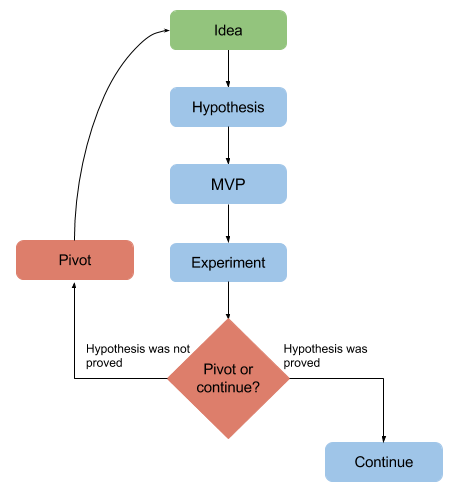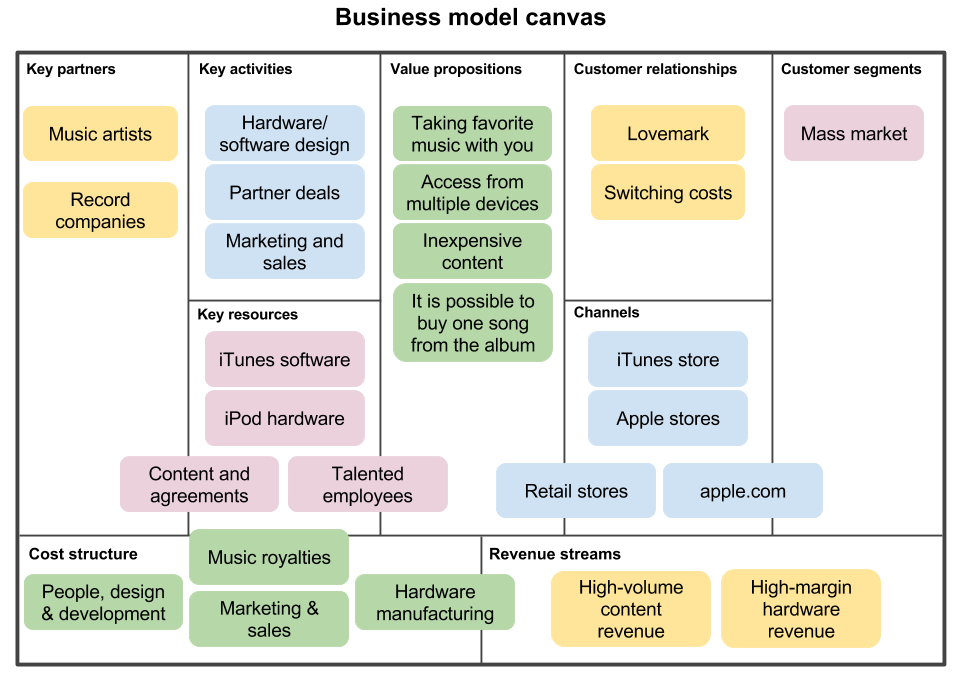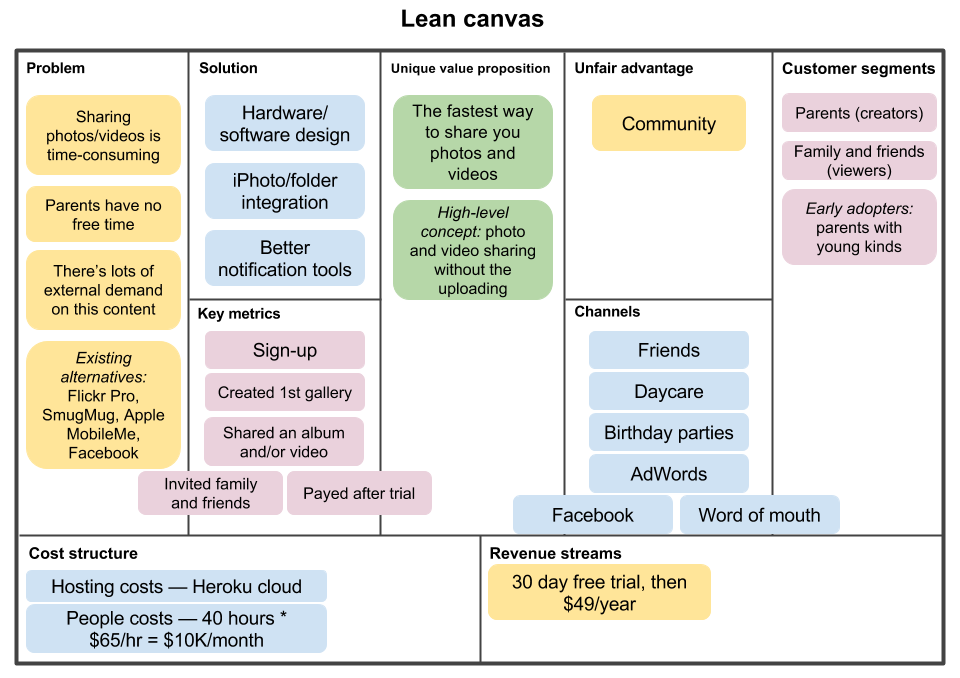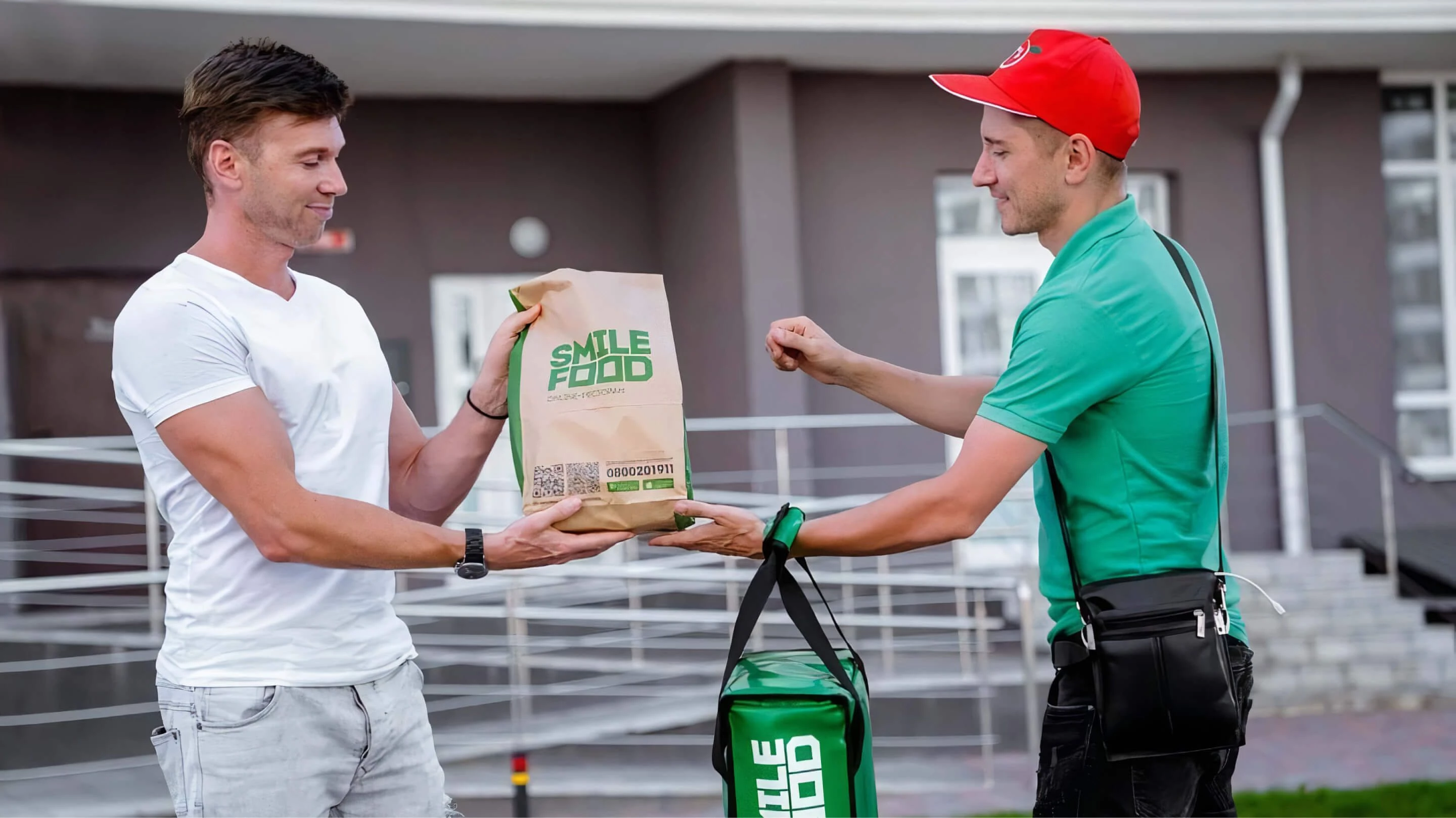
Традиційні бізнес-плани можуть бути досить трудомісткими та громіздкими. Вони часто включають довгий аналіз ринку та складні фінансові прогнози. Lean Canvas пропонує кращий варіант: простий односторінковий шаблон бізнес-плану. Він призначений для стартапів, щоб тестувати ідеї та швидко вносити зміни.
Lean Canvas спрощує планування, зосереджуючи увагу на дев'яти основних блоках. Заповнивши ці блоки, підприємці чітко розуміють свій цільовий ринок, унікальну торгову пропозицію та ключові виклики, які вони повинні вирішити. Такий ітеративний підхід полегшує швидке експериментування, заохочує ранній зворотній зв'язок з клієнтами та сприяє постійному вдосконаленню. Як результат, стартапи можуть швидко адаптуватися до мінливих ринкових умов і досягти відповідності продукту ринку.
Фахівці Stfalcon послідовно використовують модель Lean Canvas під час дослідження програмного продукту. За роки роботи ми накопичили знання про те, як отримати глибоке розуміння ринку, бізнесу наших клієнтів та їхньої цільової аудиторії. Зараз ми проведемо вас через цей процес.
Пояснення моделі Lean Canvas: Що таке lean canvas?
Аш Маур'я розробив цю модель як альтернативу Business Model Canvas. Вона допомагає стартапам зосередитися на проблемах клієнтів і знайти рішення. Ця модель спрямовує їх у наданні цих рішень своїм клієнтським сегментам з унікальною ціннісною пропозицією.
Lean canvas - це концепція розвитку стартапу, яка базується на трьох принципах:
- Замість того, щоб присвячувати місяці плануванню та глибокому дослідженню ринку для написання ґрунтовного бізнес-плану, підприємці мають сформулювати гіпотезу, а потім оцінити її з погляду business model canvas або lean canvas - діаграми, що показує, як стартап створюватиме цінність.
- Застосування клієнтоорієнтованого підходу (customer development) передбачає живе спілкування з потенційними користувачами з метою виявити їхні потреби та отримати фідбек щодо гіпотези, реалізованої у вигляді MVP. За результатами фідбеку вносяться зміни в MVP і запускається новий цикл або ж ухвалюють рішення про необхідність здійснити розворот (півот, pivot) одного з можливих типів.
- Дотримання гнучкої методології розробки (agile development) — вважається, що наприкінці кожної ітерації команда отримує готовий продукт, який потім тестується відповідно до клієнтоорієнтованого підходу і відправляється на доопрацювання.
Кожен lean-стартап функціонує відповідно до такої схеми:

Ця модель пропонує простіший варіант, ніж розширені бізнес-плани. Вона призначена для стартапів на ранніх стадіях розвитку бізнесу. Зверніть увагу, що її не слід плутати з Business Model Canvas, тому, щоб уникнути цього, давайте обговоримо їхні відмінності.
Пояснення Business Model Canvas: Що таке BMC?
Її запропонував Алекс Оствервальд у книзі "Побудова бізнес-моделей. Настільна книга стратега і новатора". Вона складається з дев'яти структурних блоків:
- Споживчі сегменти (Customer segments) - групи клієнтів, яких охоплює бізнес-модель.
- Ціннісні пропозиції (Value propositions) - переваги, які ви пропонуєте користувачам. Наприклад, у випадку з Instacart це буде можливість отримати потрібні продукти харчування, не виходячи з дому.
- Канали збуту (Distribution channels) - канали, через які здійснюється збут продукції. У випадку з додатками це буде Apple Store і Google Play.
- Взаємовідносини з клієнтами (Customer relations) - встановлюються і підтримуються всіма співробітниками, які взаємодіють з клієнтами.
- Потоки надходження доходів (Revenue streams) - звідки надходить прибуток, з разових покупок або підписок.
- Ключові ресурси (Key resources), на які спирається стартап: матеріальні, інтелектуальні, людські, фінансові.
- Ключові види діяльності (Key activities), що здійснюються стартапом.
- Ключові партнери (Key partners), які допомагають вам здійснювати діяльність: постачають ресурси або надають консультаційні чи посередницькі послуги.
- Структура витрат (Cost structure) - це витрати, пов'язані з функціонуванням моделі. Вони залежать від ключового виду діяльності, ресурсів і ключових партнерів.
Ось варіант заповнення business model canvas Алекса Оствервальда для iPod/iTunes:

У бізнес-моделі виокремлено кілька ціннісних пропозицій. Серед них - низька вартість кожного треку, можливість придбати лише одну пісню з альбому, а також зручність брати музику з собою, куди б ви не пішли. Сервіси були створені для широкої аудиторії, тому заробляли гроші, продаючи велику кількість контенту користувачам і за рахунок високих прибутків плеєрів iPod.
Щоб створити business model canvas онлайн, використайте шаблон для Google Draw.
Чому Lean Canvas важлива для стартапів?
Еш Маур'я пропонує використовувати lean startup canvas ощадливого стартапу, яку він представив у своїй книзі «Running Lean», замість канви бізнес-моделі. Він вивчав методологію ощадливого виробництва за Еріком Рісом та клієнтський розвиток за Стівом Бланком. У своєму прикладі ощадливої моделі він прагнув зосередитися лише на тих елементах, які становлять найбільший ризик. Ось вони:
- Проблема (Problem). Стартапам не вдається досягти успіху, бо вони не вирішують проблеми користувачів. Більше про вирішення проблем читайте нашій статті.
- Рішення (Solution). У моделі Еша для нього відводиться невеликий осередок, тому що воно має бути простим, як і мінімально життєздатний продукт, розроблений на його основі.
- Ключові метрики (Key metrics). Щоб не потонути в горі цифр і не обманюватися "показниками марнославства", потрібно чітко визначити показники, за якими оцінюватиметься ефективність роботи стартапу.
- Несправедлива перевага (Unfair advantage). Якщо ваш стартап унікальний, то на перших порах у нього не буде конкурентів, але з часом вони обов'язково з'являться, як це сталося з Uber. Тому вам належить знайти ту перевагу, яка вигідно відрізнятиме ваш стартап від конкурентів.
Ось варіант заповнення lean canvas Еша Маур'ї для настільного застосунку CloudFire, який він наводить у своїй книзі:

Сервіс вирішує проблему, пов'язану з витратою занадто багато часу на завантаження і вивантаження фотографій. Унікальною ціннісною пропозицією є швидкий автоматизований обмін фотографіями та відео. Послуга була передплаченою з безкоштовною пробною версією. Ключовими метриками виступали такі показники:
- реєстрація;
- створення першої галереї;
- надсилання посилання на галерею або відео друзям;
- розсилка інвайтів;
- придбання підписки.
Щоб створити lean canvas онлайн, скористайтесь шаблоном для Google Draw.
Lean canvas добре підходить для фіксації відповідей на важливі для стартапу питання:
- Яку проблему вирішує стартап?
- Як можна коротко сформулювати пропоноване рішення?
- Чим воно унікальне? Яка перевага дасть змогу стартапу залишити можливих конкурентів далеко позаду?
- Хто цільова аудиторія стартапу?
- Як вимірюватиметься ефективність стартапу?
- Через які канали здійснюватиметься просування?
- Які витрати передбачає робота стартапу?
- Як стартап буде заробляти?
Крім того, на етапі планування lean-стартапу можна також застосовувати impact mapping та інші інструменти для mind mapping.
Приклади Lean Canvas багатомільярдних стартапів
Важко сказати, які саме Lean Canvases використовували компанії, коли починали свою діяльність. Однак ми можемо поглянути на їхній шлях і зрозуміти, як ця система могла їм допомогти.
Airbnb
Airbnb спочатку зосередився на вирішенні проблем дорогих і знеособлених подорожей. Його унікальна ціннісна пропозиція - поєднати туристів з місцевими особливостями, ймовірно, зіграла вирішальну роль у його успіху.
- Проблема: Пошук доступних та унікальних місць для проживання може бути складним завданням для мандрівників. Це особливо актуально для тих, хто хоче отримати досвід, який виходить за рамки звичайних готелів.
- Рішення: Платформа, яка з'єднує мандрівників з господарями, що здають в оренду будинки, квартири або унікальні простори.
- Ціннісна пропозиція: Доступний та автентичний досвід подорожей, унікальне житло та доступ до спільноти.
- Сегменти клієнтів: Мандрівники, які шукають бюджетні варіанти, унікальні враження та місцеву атмосферу; власники житла, які мають вільні кімнати або особливі властивості.
Uber
В Lean Canvas від Uber, ймовірно, розглядалося питання ненадійності перевезень. Вона підкреслила цінність надання зручного та доступного рішення. Uber зосередився на пасажирах в місті і зайнятих професіоналах, щоб краще задовольнити їхні потреби. Це дозволило Uber адаптувати свої послуги для цього специфічного ринку.
- Проблема: Транспорт у містах часто ненадійний і непослідовний. Багатьом людям важко отримати доступ до доступних та зручних поїздок.
- Рішення: Додаток для смартфонів, що з'єднує користувачів з водіями приватних транспортних засобів, що знаходяться поблизу.
- Ціннісна пропозиція: Доступний, зручний транспорт одним натисканням кнопки, включаючи розрахунок вартості проїзду та відстеження водія.
- Сегменти клієнтів: Міські користувачі, професіонали та студенти, які шукають альтернативи таксі чи громадському транспорту.
Slack
Lean Canvas Slack, ймовірно, підкреслив проблему неефективної комунікації та продемонстрував цінність централізованої та інтегрованої платформи. Зосередившись на сегментах клієнтів, таких як бізнес і команди всередині організацій, вони змогли адаптувати свої послуги до конкретних потреб і робочих процесів.
- Проблема: Погана комунікація між членами команди знижує продуктивність і створює інформаційну ізоляцію.
- Рішення: Хмарна платформа для обміну повідомленнями та спільної роботи, яка об'єднує різні комунікаційні інструменти та функції для команд.
- Ціннісна пропозиція: Ефективна комунікація, підвищення продуктивності, кращий обмін інформацією та центральний хаб для командної співпраці.
- Сегменти клієнтів: Компанії будь-якого розміру, команди всередині організацій та окремі особи, які шукають більш ефективний спосіб спілкування та співпраці.
Переваги використання шаблону Lean Canvas
Використання шаблону Lean Canvas має багато переваг для стартапів. Це корисний інструмент для підприємців, які хочуть швидко розвивати та вдосконалювати свої бізнес-ідеї. Ось основні переваги:
- Простота та зрозумілість. Lean Model Canvas дає чіткий, односторінковий огляд складних бізнес-ідей. Це полегшує їх розуміння та поширення. Завдяки простоті, підприємці можуть зосередитися на важливих моментах, не гублячись у зайвих деталях.
- Швидкість. Lean Canvas набагато швидший у створенні та ітерації, ніж традиційні бізнес-плани. Стартапи можуть підготувати початкову версію за лічені години, що дозволяє швидше приймати рішення та тестувати ідеї.
- Гнучкість. Збираючи відгуки та дізнаючись більше про своїх клієнтів, ви можете легко оновити канву, включивши в неї нові ідеї та змінивши свою стратегію за потреби.
- Клієнтоорієнтованість. Lean Canvas наголошує на розумінні проблем клієнтів та адаптації рішень до їхніх конкретних потреб. Такий клієнтоорієнтований підхід підвищує ймовірність розробки продукту або послуги, що резонує з ринком.
- Управління ризиками. Lean Canvas допомагає знаходити потенційні проблеми та тестувати ідеї на ранніх стадіях. Це зменшує ризики та збільшує ваші шанси на успіх. Вона також спрощує процес планування, дозволяючи стартапам швидше запускати та ітерації.
- Покращена комунікація. Візуальний формат Lean Canvas полегшує спілкування та співпрацю між членами команди, інвесторами та іншими зацікавленими сторонами. Кожен може швидко зрозуміти основну бізнес-ідею та її ключові елементи.
- Покращене прийняття рішень. Lean Product Canvas забезпечує основу для прийняття обґрунтованих рішень щодо розробки продукту, маркетингу та інших ключових аспектів бізнесу. Дивлячись на інформацію на канві, ви можете знайти можливі виклики та можливості. Це допоможе вам приймати рішення на основі даних.
Як розробити Lean Canvas
Створення Lean Canvas для бізнесу передбачає розбиття вашої ідеї на основні компоненти. За своєю природою Lean Canvas розроблено таким чином, щоб поміститися на одній сторінці, і після початкового дослідження має бути завершено за один раз. Найпоширеніша помилка, яку ви можете зробити, це додати занадто мало або занадто багато інформації. Якщо вам бракує важливих даних, найкращим кроком буде повернення до початкового дослідження. Якщо у вас є багато важливих даних, які погано вписуються в Lean Canvas, краще розбити їх на кілька документів. Наприклад, ви можете створити кілька Lean Canvases, орієнтованих на різні категорії клієнтів.
Хоча Lean Canvas створено якомога гнучкішою, ми пропонуємо вам виконувати кроки в певному порядку. Блоки Lean Canvas логічно слідують один за одним.
- Крок 1: Визначте проблему
Перш ніж заповнити цей блок, ви повинні провести ретельне дослідження ринку, щоб виявити больові точки клієнтів і незадоволені потреби. Потім вам потрібно визначити конкретну проблему (або проблеми), які вирішує ваш продукт.
- Крок 2: Визначте сегменти клієнтів
Визначте свого ідеального клієнта: для кого ви намагаєтеся вирішити цю проблему? Будьте якомога точнішими, включно з віком, демографічними показниками, місцем розташування, інтересами, поведінкою, потребами тощо. Подумайте про те, щоб створити персоналізацію клієнта, щоб краще зрозуміти свою цільову аудиторію.
- Крок 3: Розробіть рішення
Проведіть мозковий штурм і оцініть можливі рішення проблеми, яку ви встановили. Це допоможе вам визначити вашу унікальну ціннісну пропозицію.
- Крок 4: Визначте потоки доходу
Визначте, як ви будете отримувати дохід. Вивчіть різні моделі ціноутворення (наприклад, підписка, одноразова покупка). Будьте реалістами та розгляньте модель ціноутворення, яка найкраще відповідає вашому бізнесу.
- Крок 5: Визначте унікальну ціннісну пропозицію
Чітко сформулюйте свою унікальну цінність. Чим ваше рішення виділяється серед конкурентів? Які ключові відмінності? Тут вам потрібно зосередитися на перевагах клієнта, а не лише на характеристиках.
- Крок 6: Визначте канали
Вирішіть, як ви охопите цільових клієнтів. Розгляньте онлайн-канали (соціальні медіа, маркетинг у пошукових системах, маркетинг електронною поштою), офлайн-канали (партнерство, події) або поєднання обох.
- Крок 7: Визначте ключові показники
Визначте ключові показники, які вимірюватимуть ваш успіх. Які дані ви будете відстежувати, щоб визначити, чи ваш бізнес на правильному шляху? Це може бути вартість залучення клієнта, постійна цінність клієнта, показник відтоку, відвідуваність веб-сайту або коефіцієнти конверсії — все, що стосується вашого бізнесу.
- Крок 8: Аналізуйте структуру витрат
Визначте та оцініть усі відповідні витрати, пов’язані з вашим бізнесом. Включіть постійні витрати (оренда, зарплата, програмне забезпечення) і змінні витрати (матеріали, виробництво, маркетинг).
- Крок 9: Визначте конкурентні переваги
Визначте фактори, які надають вашому бізнесу конкурентну перевагу. Це може включати інтелектуальну власність, сильну команду, унікальну технологію, сильний бренд і лояльну клієнтську базу — усе, що ваші конкуренти не можуть швидко скопіювати.
Пам’ятайте, що на ранній стадії ваша Lean Canvas в основному складається з припущень. У вас ще багато роботи попереду. Спочатку перевірте свої припущення. Далі зберіть відгуки клієнтів. Нарешті, відкоригуйте свою стратегію на основі того, що ви дізналися з цих кроків.
Досвід Stfalcon
Працюючи над проектами з клієнтами, ми використовували Lean Canvas як інструмента для зберігання ключової інформації під час дискавері фази (дослідження продукту). Це допомагає нам розробляти більш релевантні та індивідуальні рішення, даючи розуміння проблем і можливостей кожного клієнта.
IMBI
Imbi — це революційний соціальний застосунок, який допомагає користувачам спілкуватися, знаходити нових партнерів для спілкування та миттєво знайомитися. Для цього проекту ми завершили Lean Canvas на етапі Діскавері, щоб отримати глибше розуміння продукту. Ми приділили особливу увагу вивченню наших конкурентів, оскільки на ринку доступно багато додатків для знайомств.
Ми визначили сильні сторони нашого застосунку та розробили стратегії монетизації продукту. Ми створили дві протоперсони, кожна зі своїм сценарієм: користувач, який створює зустріч, і користувач, який відповідає на зустріч.
В результаті ми відійшли від ідей додатків для знайомств і створили простір для спілкування та обміну емоціями. Користувачі можуть планувати зустрічі швидко, легко та доступно у вибраному місці.
Smilefood
Наш клієнт звернувся до нас із проханням змінити дизайн свого застосунку для доставки їжі, який працював неефективно та давав збій при кожному оновленні. Оскільки нам доводилося мати справу з уже існуючим бізнесом, ми використовували підхід Business Model Canvas на етапі відкриття. Це дозволило нам глибоко зрозуміти бізнес і його проблеми.
Ми досліджували наших конкурентів, спілкувалися з користувачами додатків і намітили шляхи клієнтів. Ми виявили цікаву інформацію: розміщувати подальше замовлення в перші 20 хвилин дуже корисно.
Висновок
Lean Canvas — це ефективна структура, яка допомагає стартапам орієнтуватися в складнощах підприємницької діяльності. Зосереджуючись на основних елементах, таких як проблеми клієнтів, ціннісні пропозиції та потоки доходів, підприємці можуть швидко перевірити свої ідеї, визначити потенційні проблеми та прийняти обґрунтовані рішення. Такий підхід допомагає стартапам бути гнучкими та швидкими. Це дозволяє їм легко змінювати напрямок і добре реагувати на зміни на ринку. Експерти Stfalcon вже допомогли багатьом бізнесам візуалізувати їхні ідеї та перетворити їх на стратегії.
Маєте ідею для стартапу? Зв'яжіться зі Stfalcon ми допоможемо втілити ідеї!
FAQ
Які є недоліки Lean Canvas?
Хоча Lean Canvas забезпечує цінні переваги для стартапів, він також має деякі обмеження. Він може надто спрощувати складні бізнес-моделі та може не запропонувати глибини, необхідної для ретельного аналізу в певних сферах. Те, як люди бачать процес, може вплинути на результати. Зосередження на швидкій перевірці може відвернути від довгострокового планування. Крім того, він може підходити не для всіх підприємств, особливо для тих, які мають складну діяльність або працюють у суворо регульованих галузях.
Що краще вибрати Lean Canvas чи Business Model Canvas?
Вибір між Lean Canvas і Business Model Canvas залежить від ваших конкретних потреб і етапу вашого проекту. Lean Canvas найкраще підходить для стартапів на ранніх стадіях, перевірки початкових ідей і швидкого експериментування. Полотно бізнес-моделі є хорошим варіантом для більш відомих компаній. Це допомагає у стратегічному плануванні та забезпечує чітке розуміння загальної бізнес-моделі.
Чи Lean Canvas гнучкий метод?
Lean Canvas не є повним гнучким методом, як Scrum або Kanban, але містить багато ключових гнучких ідей. Ці ідеї — гнучкість, ітерація та зосередженість на клієнті. Lean Canvas сприяє постійному вдосконаленню та змінам на основі відгуків і нових ідей. Він зосереджений на клієнті та дозволяє командам налаштувати процес відповідно до своїх конкретних потреб і пріоритетів.

 Читати кейс
Читати кейс
 Читати кейс
Читати кейс


